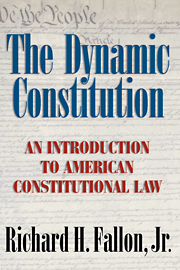Book contents
- Frontmatter
- Contents
- Preface
- Prologue: Bush v. Gore
- Introduction: The Dynamic Constitution
- Part I Individual Rights Under the Constitution
- Part II The Constitutional Separation of Powers
- Part III Further Issues of Constitutional Structure and Individual Rights
- 10 Elections, Political Democracy, and the Constitution
- 11 Structural Limits on State Power and Resulting Individual Rights
- 12 The Constitution in War and Emergency
- 13 The Reach of the Constitution and Congress's Enforcement Power
- 14 Conclusion
- Appendix: The Constitution of the United States
- Notes
- Index
12 - The Constitution in War and Emergency
Published online by Cambridge University Press: 25 July 2009
- Frontmatter
- Contents
- Preface
- Prologue: Bush v. Gore
- Introduction: The Dynamic Constitution
- Part I Individual Rights Under the Constitution
- Part II The Constitutional Separation of Powers
- Part III Further Issues of Constitutional Structure and Individual Rights
- 10 Elections, Political Democracy, and the Constitution
- 11 Structural Limits on State Power and Resulting Individual Rights
- 12 The Constitution in War and Emergency
- 13 The Reach of the Constitution and Congress's Enforcement Power
- 14 Conclusion
- Appendix: The Constitution of the United States
- Notes
- Index
Summary
[While] the Constitution protects against invasions of individual rights, it is not a suicide pact.
– Kennedy v. Mendoza-Martinez (1963)War is hell.
– General William Tecumseh ShermanOn april 12, 1861, confederate military forces fired on Fort Sumter and within a few days forced the surrender of Union soldiers stationed there. Confronted with the gravest crisis in American history, President Abraham Lincoln knew that he must convene the Congress of the United States. But Congress was large, even then, and opinionated and divided. Lincoln therefore thought that he could manage the crisis better alone. So he called Congress into session but postponed the meeting date until July 4.
In the period between April 12 and July 4, Lincoln ordered a blockade of southern ports – a step almost universally regarded as an act of war. Article I of the Constitution assigns the power “[t]o declare War” to Congress, which had not yet convened. Also before July 4, Lincoln called for volunteers for the army and ordered fifteen ships added to the navy, even though the Constitution specifically gives Congress, not the President, the powers to “raise and support Armies” and to “provide and maintain a Navy.” Doubting the loyalty of officials in the Treasury and War Departments, Lincoln directed the Secretary of the Treasury to transfer $2 million in federal funds to three private citizens charged by him to make requisitions “for the defence and support of the government” – notwithstanding the constitutional provision that “[n]o Money shall be drawn from the Treasury, but in Consequence of Appropriations made by Law.”
- Type
- Chapter
- Information
- The Dynamic ConstitutionAn Introduction to American Constitutional Law, pp. 237 - 253Publisher: Cambridge University PressPrint publication year: 2004



